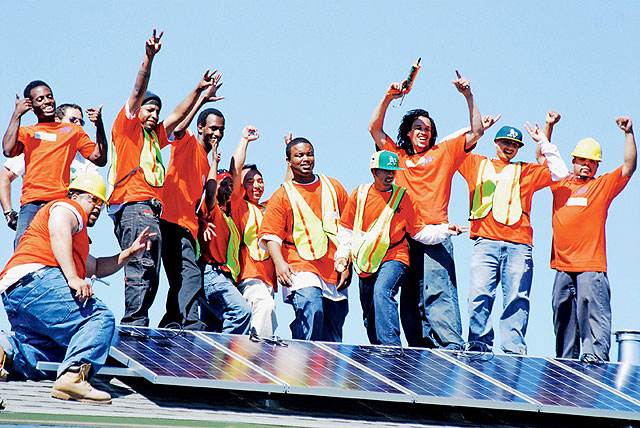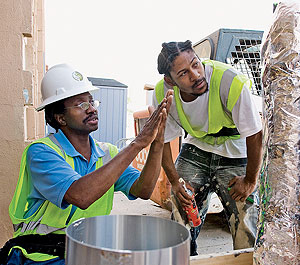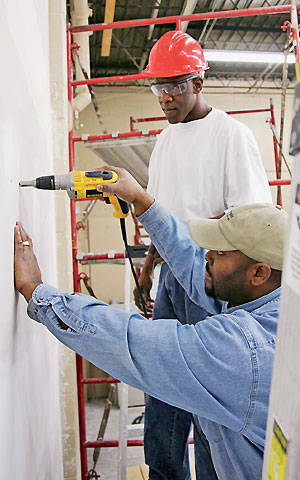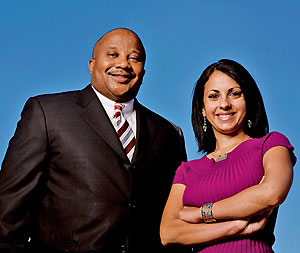sierraclub.org - sierra magazine - September/October 2009 - jobs


All Worked Up
The new issue in environmental justice: paychecks
By Katherine Glover
Anthony Turner didn't go into construction to learn about environmentalism. But after studying carpentry for three months at Summit Academy, a vocational training center in Minneapolis, the 22-year-old rattles off details about the energy efficiency of the room he's sitting in so fast that it's hard to keep up.
"That material's notorious for seeping air," he says, pointing at the ceiling. "And see how you can see right under the door? Cracks around your doors and windows account for 60 to 65 percent of energy loss, you know what I'm saying?"

Graduating trainees at Solar Richmond, a green-collar job program in California's Bay Area, celebrate a successful installation.
Summit Academy president Louis King is new to environmental issues as well. But he can tell which way the wind is blowing. King took note when, as a presidential candidate, Barack Obama repeatedly emphasized the millions of jobs the country could create in "the clean-energy future." Green jobs, Obama said in the second debate, "can be an engine that drives us into the future, the same way the computer was the engine for economic growth over the last couple of decades."
King saw opportunity, especially for those, like Turner, struggling to get a footing in the job market. Many green jobs are entry-level--installing solar panels, repairing bicycles, or working in the burgeoning recycling industry. Minnesota's winters are harsh, and thousands of plumbers, carpenters, insulators, and electricians are needed to retrofit old buildings to make them more efficient. Over the past decade, the number of green jobs in the United States has grown more than twice as fast as jobs in the overall economy, according to a Pew Charitable Trusts study released in June. In Minnesota, they've grown more than three times as fast.

Summit Academy teacher James Boney (left) instructs Jeremy Weldon in the finer points of weatherproofing Minneapolis attics.King had his doubts though, wondering what difference Obama's campaign promises would really make to rural people, the poor, and people of color. "Usually when you start talking about green and the environment, that's geared at the middle class, upper-middle class, and wealthy," he says. But there was something about the field he liked: "There's nobody who's been in it for four generations. Everybody has a shot out of the gate."
So King's Summit Academy incorporated green-building strategies into its construction program and established a 40-hour weatherization-technician training for previous graduates. To manage the supply side, King helped found a new political organization--Healthcare, Infrastructure, and Renewable Energy (HIRE) Minnesota--to make sure those green jobs pay decent wages and go to the communities that need them most. One of its first targets was the Minnesota Department of Transportation, which has had a dismal record of hiring minorities. When the department made its annual progress report to the state's House Transportation Committee in February, HIRE Minnesota flooded the meeting with community members, particularly African Americans.
"There were people standing," Turner recalls. "There were people in the hallways." Turner was there with a group of Summit Academy students, who came in full carpentry gear to show that there were qualified minorities ready and available for construction jobs. "We had our high-visibility jerseys, helmets, glasses, and boots; we came two buses deep."
HIRE Minnesota's next campaign was to mobilize support for a state energy bill that included $2.5 million for green-job training and $200 million for weatherization of low-income homes and that required state agencies to report regularly on how well the programs reached low-income families and people of color. Supporters turned out at meeting after meeting, and Minnesota governor Tim Pawlenty (R) signed it into law in May, with the federal stimulus program picking up the tab.
The campaign for green jobs got a lot of people in Turner's community thinking about things like energy efficiency. "It just wasn't common knowledge before," he says.

Some skills are more general, like the drywall techniques taught in the city's 100 Hard Hats program."This right here could change people," says Jeremy Weldon, one of Turner's classmates at Summit. "Especially about simple stuff. It's important: You don't want to live in a house that's superleaky, and then when you come to the wintertime, you're using more heat than you need."
As King and Turner found environmentalism through job training, Karen Monahan found job training through environmentalism. Monahan, who was born in Iran and grew up in Texas, is a Sierra Club-funded organizer for Environmental Justice Advocates of Minnesota. She recognized the potential of green jobs to link environmentalism to African Americans, Latinos, and others the movement has tended to leave behind. She went to a conference put on by the Blue Green Alliance, a partnership between environmental organizations (including the Sierra Club) and labor unions, but she feared the predominantly white workers and environmentalists there didn't speak in terms the unemployed black and Latino people she works with could relate to. "I was thinking, how can I bring this back to my community? This is just something that's not going to reach them," she says.
Monahan found the inspiration she was looking for in Green for All, a national organization founded by activist Van Jones that puts "the most vulnerable people at the center of its agenda," according to its Web site. That, Monahan says, "was a message I could take to the community and it would meet them where their needs were. Oftentimes, folks aren't worried about what's going to happen five years or ten years down the road; they're worried about today. They're worried about putting food in their kid's mouth. They're worried about their kids having an asthma attack."
Monahan traveled to Oakland, California, to attend the Green for All Academy. Back home, she wound up working with King to establish HIRE Minnesota. "We had the environmental-justice piece, and they had the job-training piece," Monahan says. "I knew we were limited with the resources we have and this had to be a coalition campaign."
HIRE Minnesota's coalition includes Southeast Asians who have settled in the Twin Cities area. "We're just trying to keep abreast of any job opportunities," says Bryan Thao Worra of the Lao Assistance Center, which has been flooded with people who have lost their jobs and now face foreclosure. The Hmong American Mutual Assistance Association is another coalition member, but executive director Xang Vang wonders whether green jobs will really be available for local Hmong, many of whom are refugees with limited English and no technology skills. "Where is the pie for us?" he asks.
As billions of taxpayer dollars start gushing in for green jobs, activists like Monahan want to make sure the funds benefit victims of environmental injustice. Historically, companies and public agencies have tended to locate landfills, incinerators, and other dirty facilities near neighborhoods that are predominantly black or Latino. Even poor white neighborhoods fare better, says San Francisco State University urban studies professor Raquel Pinderhughes. Monahan links this injustice to a wide spectrum of social ills. She notes, for example, that African Americans have the highest rate of asthma and that asthma is the number-one reason students miss school. This means students learn less, get lower test scores, and as a result, drop out more often than their healthy peers. And people without education are the most likely to turn to crime.

Coalition politics: In Louis King and Karen Monahan, job training meets environmental justice."One solution," says Monahan, "is a good green job."
The idea isn't new. Chicago has been running a green-jobs program since 1994, training people in fields like landscaping, horticulture, and computer recycling. Similar programs have sprung up in recent years from Oakland to Newark, New Jersey, many targeting people with criminal records and others who have a hard time landing a job.
Today's green jobs, says Pinderhughes, are a perfect match for the underserved. Because the industries are new, there are few formal technical programs, so most companies provide on-the-job training. Plus, relative to other entry-level opportunities, green jobs tend to pay higher wages, often with benefits. On top of it all, she adds, the work is rewarding. "There's nothing exciting about crawling into an attic and insulating it, but if you understand that you are helping your community, that can take you the extra mile," Pinderhughes says. "Green jobs are inherently meaningful and dignified."
With Obama in office, the green jobs stars would appear to have aligned. Green for All's Van Jones now works at the White House Council on Environmental Quality, and Labor secretary Hilda Solis is one of the authors of the Green Jobs Act of 2007, which authorized up to $125 million a year for training (which the Bush administration failed to appropriate). "It excites me that the woman who worked really hard on that bill is now the person who's going to oversee its administration," says Ian Kim, director of Oakland's Green-Collar Jobs Campaign.
"We're trying to turn this into an opportunity to do things the right way," Monahan says. "This is a long-term investment, not just a quick stimulus."
"What we're talking about," says Phaedra Ellis-Lamkins, the new CEO of Green for All, "is the transformation of an economy."
Katherine Glover is a freelance writer living in Minneapolis.
This article was funded by the Sierra Club's Environmental Justice and Community Partnerships program, whose goal is to explore and discuss the link between environmental quality and social justice.
Photos, from top: Courtesy of Solar Richmond and RichmondBUILD, Richmond, CA; Sara Jorde; Summit Academy OIC; Sara Jorde; used with permission